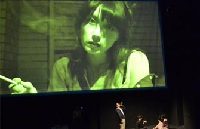 |
| Multimedia play has charm of old film |
 |
| Injured dancer to return to stage |
I was instantly smitten by its architectural uniqueness and, days later, my infatuation had not ebbed a bit. There were indeed some surprises when I got on the premises. It was much smaller than I had imagined, at least not nearly as spacious as Beijing's National Center for the Performing Arts. There are lots of small rooms and corridors, but not a single mammoth foyer like the NCPA has. That means you have a great many choices of location for pre-performance and intermission chitchat.
I would suggest taking in a show instead of a guided tour. As the six performing venues of the complex offer a total of 1,600 performances each year, chances are many of them would be off-limits to tourists on any given day. I could access only the 200-seat Jorn Utzon room during a specially arranged tour. On the plus side, tours are available in six languages including Mandarin Chinese.
The best way to experience Sydney Opera House is to sit inside the halls. You don't need to be an opera buff to feel its charm. Many of the shows on offer are extremely accessible even to a non-classical music devotee.
The show that happened to fit into my schedule was The Magic Flute by Mozart. It was the celebrated production by Julie Taymor, licensed from the Metropolitan Opera of New York. However, it was slightly abridged and presented in English rather than the original German. The bird catcher was so hilarious he almost brought the house down. It helped that the 1,500-seat house was so intimate you could be a couple of meters away from the singers.
I first saw the inside of the house on a videotape. It was the 1990 farewell performance of Dame Joan Sutherland and was attended by a huge phalanx of dignitaries. I fell in love with Western opera partly through recordings by Dame Joan and Pavarotti that were frequently aired on radio stations in Beijing in the mid-1980s. The sheer beauty and technical wizardry of that voice took my breath away. Later when I was studying in the United States, I sought out every recording she had made.
Imagine how I felt when I spotted the sign "Joan Sutherland Theater", which is now the official name for the opera hall of the complex. A spine-tingling frisson ran through me when I thought this great lady of opera, who hailed from Australia, once sang on this stage, a stage she could call her home and that now bears her name. She often ended her night with a rendition of Home, Sweet Home.
This year, the world's most famous cluster of seashells is graced by a new generation of luminaries, including German tenor Jonas Kaufmann, American soprano Christine Goerke, New Zealand soprano Kiri Te Kanawa and violinist Anne-Sophie Mutter, among others. Under the baton of David Robertson, the Sydney Symphony Orchestra, its resident orchestra, will tour the Chinese cities of Beijing, Shanghai, Guangzhou, Shen-zhen, Jinan and Xiamen in June.
